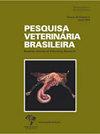巴西南部奶牛乳腺炎相关细菌的物种鉴定和抗菌敏感性分析
IF 0.8
4区 农林科学
Q3 VETERINARY SCIENCES
引用次数: 2
摘要
摘要:牛乳腺炎是奶牛最常见的疾病,也是造成牛奶行业经济损失的主要原因。本研究旨在鉴定主要菌种,并评估巴西南部奶牛场乳腺炎奶牛群中分离的细菌对抗生素的敏感性。研究人员从巴西南部一个重要乳制品产区的不同奶牛群中采集了107份牛奶样本,其中包括位于巴西南大德州东北部地区10个城市的农场。分离出细菌菌株,并采用经典细菌学方法进行推定鉴定。采用MALDI-TOF质谱法鉴定菌种,并对奶牛养殖场常用的12种抗菌药物进行药敏试验。共分离到51株细菌,推定鉴定为葡萄球菌(82.3%)、芽孢杆菌(3.9%)、克雷伯氏菌(3.9%)、链球菌(3.9%)、棒状杆菌(2%)、肠球菌(2%)和沙雷氏菌(2%)。在MALDI-TOF分析中成功鉴定出41株分离菌株,其中35株来自11个不同的菌种。重要的是,有8种不同的葡萄球菌,其中色素葡萄球菌(48.6%)和金黄色葡萄球菌(20%)的频率较高。总体而言,细菌分离株对青霉素(46.3%)、四环素(39%)、阿莫西林(36.6%)、氨苄西林(34.1%)和磺胺甲恶唑/甲氧苄啶(31.7%)耐药。恩诺沙星是唯一的抗菌药物,所有分离株均敏感。此外,有6株多重耐药菌株(5株显色葡萄球菌和1株金黄色葡萄球菌)。这项研究强调,在巴西南部一个非常重要的产奶地区的奶牛场的奶牛中发现了对几种抗菌素具有耐药性的细菌病原体。牛乳腺炎病原菌的微生物鉴定和抗菌谱的测定是合理用药的必要条件。本文章由计算机程序翻译,如有差异,请以英文原文为准。
Species identification and antimicrobial susceptibility profile of bacteria associated with cow mastitis in southern Brazil
ABSTRACT: Bovine mastitis is the most common disease in dairy cattle and responsible for economic losses in the milk industry. The present study aimed to identify the main species and to evaluate the antimicrobial susceptibility of bacterial isolates from cow herds with mastitis in dairy farms from southern Brazil. A total of 107 milk samples were collected from different cow herds in one important dairy producing region in southern Brazil, including farms located in ten cities from the Northeast region in the Rio Grande do Sul state. Bacterial strains were isolated and submitted to presumptive identification by classical bacteriological methods. Bacterial species were also identified by MALDI-TOF MS and antimicrobial susceptibility testing was performed with 12 antimicrobials commonly used in dairy farms. Fifty-one bacterial strains were isolated and the presumptive identification demonstrated the occurrence of Staphylococcus spp. (82.3%), Bacillus spp. (3.9%), Klebsiella spp. (3.9%), Streptococcus spp. (3.9%), Corynebacterium sp. (2%), Enterococcus sp. (2%) and Serratia sp. (2%). Forty-one isolates were successfully identified in the MALDI-TOF analysis, including 35 isolates from eleven different bacterial species. Importantly, there were eight different Staphylococcus species, with a high frequency of Staphylococcus chromogenes (48.6%) and Staphylococcus aureus (20%). Overall, bacterial isolates demonstrated resistance to penicillin (46.3%), tetracycline (39%), amoxicillin (36.6%), ampicillin (34.1%) and sulfamethoxazole/trimethoprim (31.7%). Enrofloxacin was the unique antimicrobial that all isolates were susceptible. In addition, there were six multidrug resistant isolates (five S. chromogenes and one S. aureus). This study highlights that bacterial pathogens with resistance to several antimicrobials were identified in cows from dairy farms in a very important milk producing region located in southern Brazil. Microbial identification of the bovine mastitis pathogens and determination of the antimicrobial profile is necessary for the rational use of the medicines.
求助全文
通过发布文献求助,成功后即可免费获取论文全文。
去求助
来源期刊

Pesquisa Veterinaria Brasileira
农林科学-兽医学
CiteScore
1.30
自引率
16.70%
发文量
41
审稿时长
9-18 weeks
期刊介绍:
Pesquisa Veterinária Brasileira - Brazilian Journal of Veterinary Research (http://www.pvb.com.br), edited by the Brazilian College of Animal Pathology in partnership with the Brazilian Agricultural Research Organization (Embrapa) and in collaboration with other veterinary scientific associations, publishes original papers on animal diseases and related subjects. Critical review articles should be written in support of original investigation. The editors assume that papers submitted are not being considered for publication in other journals and do not contain material which has already been published. Submitted papers are peer reviewed.
The abbreviated title of Pesquisa Veterinária Brasileira is Pesqui. Vet. Bras.
 求助内容:
求助内容: 应助结果提醒方式:
应助结果提醒方式:


